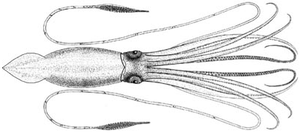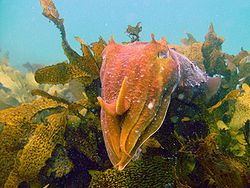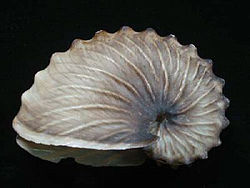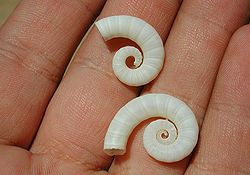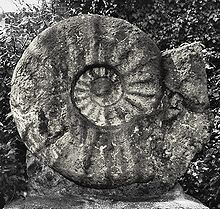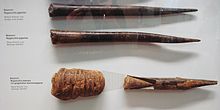- Cephalopod size
-
The giant squid (Architeuthis sp.) was for a long time thought to be the largest extant cephalopod. It is now known that the colossal squid (Mesonychoteuthis hamiltoni) attains an even greater size.

Size has been one of the most interesting aspects of cephalopod science to the general public. This article lists the largest cephalopods from various groups, sorted in order of mantle length, total length, weight, and shell diameter. Extinct taxa are also included.
Contents
Mantle length
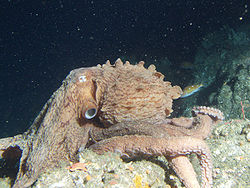 Giant Pacific Octopus, Enteroctopus dofleini
Giant Pacific Octopus, Enteroctopus dofleini
Octopoda (octopuses) Species Maximum mantle length References Notes Haliphron atlanticus 0.69 m O'Shea (2004) Enteroctopus dofleini 0.6 m Norman (2000:214) Sepiida (cuttlefish) Species Maximum mantle length References Notes Sepia apama 0.5 m Reid et al. (2005:68) Sepia latimanus 0.5 m Reid et al. (2005:92) Sepia hierredda <0.5 m Reid et al. (2005:88) Sepia officinalis 0.49 m Reid et al. (2005:99) Sepia pharaonis 0.42 m Reid et al. (2005:107) Sepia lycidas 0.38 m Reid et al. (2005:96) Sepia ramani 0.375 m Reid et al. (2005:114) Sepiolida (bobtail squid) Species Maximum mantle length References Notes Austrorossia antillensis 0.09 m Reid & Jereb (2005:192) Rossia pacifica 0.09 m (female) Reid & Jereb (2005:185) Male grows to 45 mm in mantle length (Reid & Jereb, 2005). Rossia macrosoma 0.085 m Reid & Jereb (2005:184) More typically the mantle length is 20–60 mm (Reid & Jereb, 2005). Neorossia caroli 0.083 m (female) Reid & Jereb (2005:190) Male grows to 51 mm in mantle length (Reid & Jereb, 2005). Spirulida (Ram's Horn Squid) (only one extant species) Species Maximum mantle length References Notes Spirula spirula rarely exceeds 0.045 m Reid (2005:211) Teuthida (squid) Species Maximum mantle length References Notes Mesonychoteuthis hamiltoni 4 m (estimate) O'Shea (2005a) Estimate based on largest known beak (LRL: 49 mm). Galiteuthis phyllura 2.65–2.75 m (estimate) Nesis (1985) Estimate based on 0.4 m long arm and 1.15 m tentacle. Architeuthis sp.† 2.25 m O'Shea (2005a) Onykia robusta 2 m Norman (2000:174) Kubodera et al. (1998) give maximum of at least 1.615 m. Megalocranchia fisheri 1.8 m Tsuchiya & Okutani (1993) Dosidicus gigas 1.75 m Glaubrecht & Salcedo-Vargas (2004) Norman (2000:165) gives maximum of 1.5 m. Taningia danae 1.7 m Nesis (1982) Kondakovia longimana probably 1.15+ m (estimate) O'Shea (2005b) Longest confirmed specimen measures 0.85 m (O'Shea, 2005b). Total length to at least 2.3 m (Carrington, 2000). Lepidoteuthis grimaldii 1 m Young & Vecchione (2009) Thysanoteuthis rhombus 1 m Roper et al. (1984) Commonly grows to a mantle length of 0.6 m (Roper et al., 1984). cf. Magnapinna ~1 m (estimate) Vecchione et al. (2001) Estimate based on specimen observed by ROV Tiburon in May 2001, north of Oahu, Hawaii, at a depth of 3380 m. Vampyromorphida (Vampire Squid) (only one extant species) Species Maximum mantle length References Notes Vampyroteuthis infernalis 0.13 m Nesis (1982) ^ †The taxonomy of the giant squid has not been entirely resolved. Lumpers and splitters may propose as many as eight species or as few as one. No genetic or physical basis for distinguishing between the named species has been proposed.
Total length
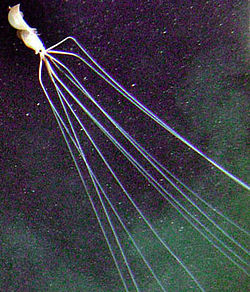 A long-arm squid (cf. Magnapinna) filmed in the Gulf of Mexico.
A long-arm squid (cf. Magnapinna) filmed in the Gulf of Mexico.
Octopoda (octopuses)
Not to be confused with armspan, which is approximately double the total length.Species Maximum total length References Notes Enteroctopus dofleini >6.1 m Cosgrove (1987) Haliphron atlanticus 4 m (estimate) O'Shea (2004) Estimate based on incomplete 2.90 m specimen. Teuthida (squid)
Total length including long feeding tentacles.Species Maximum total length References Notes Mesonychoteuthis hamiltoni 14 m (estimate) O'Shea (2005a) Estimate based on largest known beak (LRL: 49 mm). Architeuthis sp. 13 m (female) O'Shea (2005a) Measured post mortem and relaxed. Older records were exaggerated by stretching of the tentacles (O'Shea, 2005a). cf. Magnapinna at least 8 m (estimate) Bolstad (2003) Estimate based on video evidence. Asperoteuthis acanthoderma 5.5 m Tsuchiya & Okutani (1993) Length of immature specimen measuring 0.45 m ML. Largest known specimen (0.78 m ML) would presumably be longer if it were complete (Okutani, 1995). Onykia robusta over 4 m Verrill (1876) Galiteuthis phyllura over 4 m (estimate) Nesis (1985) Estimate based on 0.40 m long arm and 1.15 m tentacle. Weight
Octopoda (octopuses) Species Maximum weight References Notes Haliphron atlanticus 75 kg (estimate) O'Shea (2004) Estimate based on incomplete 61.0 kg specimen. Enteroctopus dofleini 71 kg Cosgrove (1987) Weight of live specimen. There exists a highly dubious record of a 272 kg specimen (High, 1976). Sepiida (cuttlefish) Species Maximum weight References Notes Sepia apama >10.5 kg Reid et al. (2005:68) Sepia latimanus 10 kg Reid et al. (2005:92) Sepia hierredda >7.5 kg Reid et al. (2005:88) Sepia lycidas 5 kg Reid et al. (2005:96) Sepia pharaonis 5 kg Reid et al. (2005:107) Sepia officinalis 4 kg Reid et al. (2005:99) Teuthida (squid) Species Maximum weight References Notes Mesonychoteuthis hamiltoni 495 kg [Anonymous] (2007) Weight of mature specimen caught in early 2007. Originally estimated to weigh 450 kg (Anderton, 2007). Architeuthis sp. 275 kg (female) O'Shea (2005a) Taningia danae 61.4 kg Kubodera et al. (2006) Onykia robusta 50 kg Roper et al. (1984) Dosidicus gigas 50 kg Nigmatullin et al. (2001) Thysanoteuthis rhombus 30 kg Miyahara et al. (2006) Shell diameter
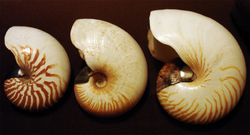 Nautilus shells: N. macromphalus (left), A. scrobiculatus (centre), N. pompilius (right).
Nautilus shells: N. macromphalus (left), A. scrobiculatus (centre), N. pompilius (right). Argonauta hians shell, 121.5 mm in diameter.
Argonauta hians shell, 121.5 mm in diameter.
Nautilida (nautiluses) (all extant species listed) Species Maximum shell diameter References Notes Nautilus pompilius pompilius 268 mm [1] Pisor (2005:93) lists maximum shell diameter of 254.0 mm. Nautilus repertus is treated here in synonymy with N. pompilius pompilius. Pisor (2005:93) lists 230.0 mm record for N. repertus. Nautilus belauensis 226 mm Jereb (2005:54) Allonautilus scrobiculatus 215.0 mm Pisor (2005:93) Nautilus stenomphalus 201.0 mm Pisor (2005:93) Allonautilus perforatus around 180 mm Jereb (2005:55) Nautilus macromphalus 180.0 mm Pisor (2005:93) Nautilus pompilius suluensis 160 mm [2] Pisor (2005:93) lists maximum shell diameter of 148.0 mm. Octopoda (octopuses) (all extant Argonauta species listed)
Females of the genus Argonauta produce a calcareous eggcase in which they reside.Species Maximum shell diameter References Notes Argonauta argo 300.0 mm Pisor (2005:12) Argonauta nodosa 292.0 mm Pisor (2005:12) Argonauta pacifica‡ 220.0 mm Pisor (2005:12) Argonauta hians 112.6 mm Pisor (2005:12) Argonauta cornuta‡ 98.6 mm Pisor (2005:12) Argonauta nouryi 95.5 mm Pisor (2005:12) Argonauta bottgeri 67.0 mm Pisor (2005:12) Spirulida (Ram's Horn Squid) (only one extant species)
The Ram's Horn Squid possesses a chambered internal shell, which it uses for buoyancy control.Species Maximum shell diameter References Notes Spirula spirula 28.8 mm [3] Pisor (2005:108) lists maximum shell diameter of 26.9 mm. ^‡ Species status questionable.
Extinct taxa
Ammonoidea (ammonites) Species Maximum shell diameter References Notes Parapuzosia seppenradensis 2.55 m (estimate) Kennedy & Kaplan (1995) Estimate based on 1.95 m diameter specimen with an incomplete living chamber. Belemnoidea (belemnites) Species Maximum rostrum length References Notes Megateuthis gigantea 0.46 m Eyden (2003) The whole belemnite is estimated to have been 3–5 m long. Nautiloidea (nautiloids) Species Maximum shell length References Notes Cameroceras sp. 11 m (estimate) Teichert & Kümmel (1960) Frey (1995) gives a maximum length of up to 6 m. Vampyromorphida (vampire squid) Species Maximum mantle length References Notes Tusoteuthis longa over 1.8 m (estimate) Eyden (2004) See also
References
- [Anonymous] 2007. Colossal squid may be headed for oven. Associated Press.
- Anderton, H.J. 2007. Amazing specimen of world's largest squid in NZ. New Zealand Government website.
- Bolstad, K. 2003. Deep-Sea Cephalopods: An Introduction and Overview. The Octopus News Magazine Online.
- Carrington, D. 2000. Big squid breaks record. BBC News, July 3, 2000.
- Cosgrove, J.A. 1987. Aspects of the Natural History of Octopus dofleini, the Giant Pacific Octopus. M.Sc. Thesis. Department of Biology, University of Victoria (Canada), 101 pp.
- Eyden, P. 2003. Belemnites: A Quick Look. The Octopus News Magazine Online.
- Eyden, P. 2004. Cretaceous Giant Squid. The Octopus News Magazine Online.
- Frey, R.C. 1995. Middle and Upper Ordovician nautiloid cephalopods of the Cincinnati Arch region of Kentucky, Indiana, and Ohio.PDF U.S. Geological Survey.
- Glaubrecht, M. & M.A. Salcedo-Vargas 2004. The Humboldt squid Dosidicus gigas (Orbigny, 1835): History of the Berlin specimen, with a reappraisal of other (bathy-)pelagic gigantic cephalopods (Mollusca, Ommastrephidae, Architeuthidae). Zoosystematics and Evolution 80(1): 53–69. doi:10.1002/mmnz.20040800105
- High, W.L. 1976. The giant Pacific octopus. U.S. National Marine Fisheries Service, Marine Fisheries Review 38(9): 17-22.
- Jereb, P. 2005. Family Nautilidae. In: P. Jereb & C.F.E. Roper, eds. Cephalopods of the world. An annotated and Illustrated catalogue of species known to date. Volume 1. Chambered nautiluses and sepioids (Nautilidae, Sepiidae, Sepiolidae, Sepiadariidae, Idiosepiidae and Spirulidae). FAO Species Catalogue for Fishery Purposes No. 4, Vol. 1. FAO, Rome. pp. 51–55.
- (German) Kennedy, W.J. & U. Kaplan 1995. Parapuzosia (Parapuzosia) seppenradensis (LANDOIS) und die Ammoniten fauna der Dülmener Schichten, Westfalen. Geol. Paläont. Westf. 33: 127 p., 43 pls.
- Kubodera, T., U. Piatkowski, T. Okutani & M.R. Clarke. 1998. Taxonomy and Zoogeography of the Family Onychoteuthidae (Cephalopoda: Oegopsida). Smithsonian Contributions to Zoology 586: 277-291.
- Kubodera, T., Y. Koyama & K. Mori 2006. Observations of wild hunting behaviour and bioluminescence of a large deep-sea, eight-armed squid, Taningia danae.PDF (295 KB) Proceedings of the Royal Society B: Biological Sciences 274(1613): 1029–1034. doi:10.1098/rspb.2006.0236
- Miyahara, K., K. Fukui, T. Ota & T. Minami 2006. Laboratory observations on the early life stages of the diamond squid Thysanoteuthis rhombus. Journal of Molluscan Studies 72(2): 199–205. doi:10.1093/mollus/eyi068
- (Russian) Nesis, K.N. 1982. Abridged key to the cephalopod mollusks of the world's ocean. Light and Food Industry Publishing House, Moscow. 385+ii pp. [Translated into English by B. S. Levitov, ed. by L. A. Burgess 1987. Cephalopods of the world. T.F.H. Publications, Neptune City, NJ. 351pp.]
- (Russian) Nesis, K.N. 1985. A Giant Squid in the Sea of Okhotsk. Priroda 10: 112-113. [Translated from Russian by Yuri Nektorenko.]
- Nigmatullin, C.M., K.N. Nesis & A.I. Arkhipkin 2001. A review of the biology of the jumbo squid Dosidicus gigas (Cephalopoda: Ommastrephidae). Fisheries Research 54(1): 9–19. doi:10.1016/S0165-7836(01)00371-X
- Norman, M.D. 2000. Cephalopods: A World Guide. ConchBooks.
- Norman, M.D. & A. Reid 2000. A Guide to Squid, Cuttlefish and Octopuses of Australasia. CSIRO Publishing.
- Okutani, T. 1995. Cuttlefish and squids of the world in color. Publication for the 30th anniversary of the foundation of the National Cooperative Association of Squid Processors. 185 pp.
- O'Shea, S. 2004. The giant octopus Haliphron atlanticus (Mollusca : Octopoda) in New Zealand waters. New Zealand Journal of Zoology 31(1): 7-13.
- O'Shea, S. 2005a. Giant Squid and Colossal Squid Fact Sheet. The Octopus News Magazine Online.
- O'Shea, S. 2005b. Kondakovia longimana. In: Giant Squid and Colossal Squid Fact Sheet. The Octopus News Magazine Online.
- Pisor, D.L. 2005. Registry of World Record Size Shells: Fourth Edition - 2005. Snail's Pace Productions and ConchBooks.
- Reid, A. 2005. Family Spirulidae. In: P. Jereb & C.F.E. Roper, eds. Cephalopods of the world. An annotated and illustrated catalogue of species known to date. Volume 1. Chambered nautiluses and sepioids (Nautilidae, Sepiidae, Sepiolidae, Sepiadariidae, Idiosepiidae and Spirulidae). FAO Species Catalogue for Fishery Purposes No. 4, Vol. 1. FAO, Rome. pp. 211–212.
- Reid, A. & P. Jereb 2005. Family Sepiolidae. In: P. Jereb & C.F.E. Roper, eds. Cephalopods of the world. An annotated and illustrated catalogue of species known to date. Volume 1. Chambered nautiluses and sepioids (Nautilidae, Sepiidae, Sepiolidae, Sepiadariidae, Idiosepiidae and Spirulidae). FAO Species Catalogue for Fishery Purposes No. 4, Vol. 1. FAO, Rome. pp. 153–203.
- Reid, A., P. Jereb, & C.F.E. Roper 2005. Family Sepiidae. In: P. Jereb & C.F.E. Roper, eds. Cephalopods of the world. An annotated and illustrated catalogue of species known to date. Volume 1. Chambered nautiluses and sepioids (Nautilidae, Sepiidae, Sepiolidae, Sepiadariidae, Idiosepiidae and Spirulidae). FAO Species Catalogue for Fishery Purposes No. 4, Vol. 1. FAO, Rome. pp. 57–152.
- Roper C.F.E., M.J. Sweeney & C.E. Nauen 1984. Cephalopods of the world. Food and Agriculture Organization, Rome, Italy.
- Teichert, C. & B. Kümmel 1960. Size of Endocerid Cephalopods. Breviora Mus. Comp. Zool. 128: 1–7.
- Tsuchiya, K. & T. Okutani 1993. Rare and interesting squids in Japan -X. Recent occurrences of big squids from Okinawa. Venus 52: 299-311.
- Vecchione, M., R.E. Young, A. Guerra, D.J. Lindsay, D.A. Clague, J.M. Bernhard, W.W. Sager, A.F. Gonzalez, F.J. Rocha & M. Segonzac 2001. Vecchione et al., 2001. Cephalopods in Action.
- Verrill, A.E. 1876. Notes on gigantic cephalopods, a correction. American Journal of Science and Arts 12(3): 236-237.
- Young, R.E. & M. Vecchione 2009. Lepidoteuthidae Pfeffer 1912. The Tree of Life Web Project.
Categories:- Cephalopods
- Size
Wikimedia Foundation. 2010.

